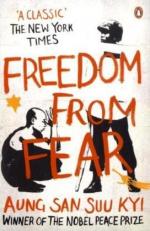
|
| Name: _________________________ | Period: ___________________ |
This test consists of 15 multiple choice questions and 5 short answer questions.
Multiple Choice Questions
1. In her letter to the editor dated 14 April 1989, what was the result of the difficulties that Suu Kyi encountered?
(a) She heard a rumor that the Burmese government would have a dialogue.
(b) She was allowed visitors.
(c) Somone countermanded the order at the last minute.
(d) The United Nation was investigating the alleged charges of human rights violations.
2. What was the Burmese government's initial approach toward Suu Kyi and her supporters mentioned in Josef Silverstein's essay?
(a) The government warned people to stay away from her rallies.
(b) They disregarded the events because they thought the movement would not take hold in Burma.
(c) The government collected dossiers on Suu Kyi and her supporters.
(d) The government monitored Suu Kyi's movements.
3. Who escorts Suu Kyi to the event she describes in her letter to the editor dated January 21, 1989?
(a) Her sons.
(b) A flotilla of troops.
(c) Her supporters.
(d) The people of Burma.
4. How did Suu Kyi conclude her letter to the editor dated January 21,1989?
(a) That Mying Aung "is going to get it."
(b) That Myint Aung "will get his just desserts."
(c) That Myint Aung "will get what's coming to him."
(d) That Myint Aung "will get a good run for his money."
5. In her undated letter to the United Nations, Suu Kyi distinguishes between
(a) Rule of law and law and order.
(b) A single party political system and a multi-party political system.
(c) The tyrrany of an oppressive regime and the will of the people.
(d) Human rights and political rights.
6. What does Suu Kyi find when she reaches her destination that she describes in her letter to the editor dated January 21, 1989?
(a) The residents have lined the streets with flowers.
(b) She is denied entry by the army.
(c) The streets are blocked off.
(d) There is graffitti with messages of support.
7. What about Aung San Suu Kyi's personal characteristics exalted her to become the spokesperson for the democratic movement in Burma, according to Josef Silverstein?
(a) Her intelligence.
(b) Her political savvy.
(c) Her eloquence.
(d) Her modesty.
8. What other organizations has Suu Kyi made appeals about the violation of human rights in Burma?
(a) Internation Institute for Democracy and Electoral Assistance and the Lautaro Lodge.
(b) Amnesty International and the National Commission of Jurists.
(c) Human Rights Watch and Genocide Watch.
(d) Commonweath of Nations and No Peace Without Justice.
9. In an interview with Dominic Falder on AsiaWeek in July 1989, what is Suu Kyi's response to the question, "what would happen after the elections, if there were elections?"
(a) "We would never have an election."
(b) "The NLD would win by a landslide."
(c) "We shall see if justice would be served."
(d) "We don't know. This is the problem."
10. In her essay, how does Ann Pasternak Slater describe Suu Kyi?
(a) As a very humble woman.
(b) As a courageous woman.
(c) As a talented, self-disciplined woman.
(d) As an opportunist.
11. What are Suu Kyi's comments about economic development in her interview with Dominic Falder on AsiaWeek in July 1989?
(a) The government cannot build a system with nothing to support it.
(b) Having economic development is useless when basic human rights are not being provided.
(c) It must be preceded by fundamental political changes.
(d) You need foreign investment, but the global community is currently boycotting Burma.
12. In Ma Than E's essay, why did Suu Kyi leave London for Rangoon?
(a) To be at her mother's bedside.
(b) She was homesick.
(c) She was called to lead the people.
(d) Because of the political struggle.
13. In Suu Kyi's speech on December 3, 1988, what are Suu Kyi's beliefs about democracy in Burma?
(a) Democracy is still possible.
(b) Democracy is around the corner.
(c) Democracy can only exist in Burma in an adulterated form.
(d) Democracy is an illusive dream.
14. In Ma Than E's essay, who accepts the Sakharov award for Aung San Suu Kyi?
(a) Suu Kyi's husband.
(b) Ma Than E.
(c) U Than Tun.
(d) Suu Kyi's 13-year-old son Kim.
15. Who does Suu Kyi ask to press about the human rights violations in Burma in her open letter dated September 26, 1988?
(a) The members of the United Nations General Assembly
(b) Ambassadors from countries recognized by the Burmese government.
(c) World Leaders.
(d) The citizens of the world.
Short Answer Questions
1. What was the second reason why Suu Kyi submitted her papers for candidacy for the election in May 1990?
2. In Josef Silverstein's essay, what does a shopkeeper say about comparing Suu Kyi to the government leaders after attending one of her rallies?
3. In her undated letter to the United Nations, what is Suu Kyi's hope for the United Nation's role in Burma?
4. How does Aung San Suu Kyi conclude her speech that she delivered at a pagoda in Myitkyina, Kachin State on April 27, 1989?
5. In Suu Kyi's undated letter to the United Nations, she states that "those who embrace the cause of human rights...
|
This section contains 1,001 words (approx. 4 pages at 300 words per page) |

|




